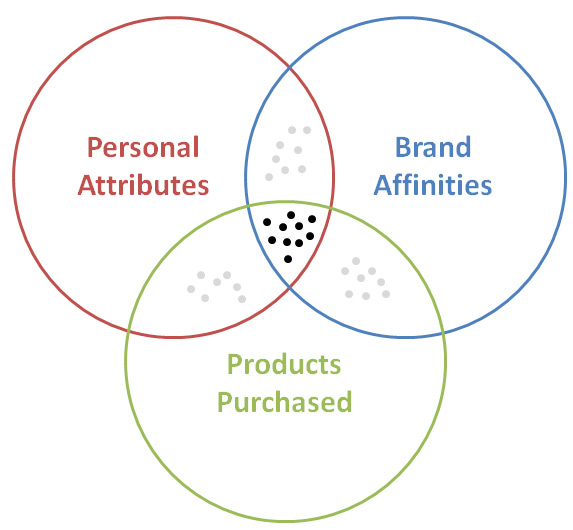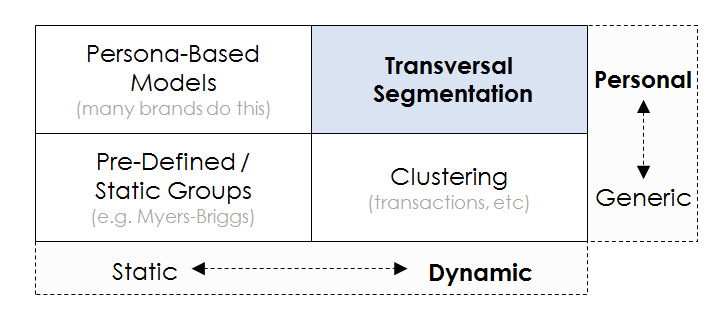The method that we use to segment consumers into distinct groups is called Transversal Segmentation. This is a new method that enables powerful targeting and analysis of groups of accounts in a way that's very similar to a real-time focus group. Compared to other consumer segmentation methods, Transversal Segmentation is fast to setup, enables dynamic consumer targeting, and also surfaces relevant personal details, all while remaining fully GDPR compatible.
We make use of three main dimensions to help determine when an account belongs to a particular group: 1) Personal Attributes, 2) Products Used, and 3) Brand Affinities. Luckily, all of this data is available on social media, which enables a continuous flow of insights in a way that's very similar to a live focus group.

Each of these attributes can be obtained from social posts. The Personal Attributes dimension consists of items such as psychographics, geography, behavioristics, interests, and activities. These parameters come either from visual search or metadata. We use object detection to see what things are present in every photo and video. An example would be the age of a person in a selfie, the fact that she rides horses every week, that she enjoys soccer, or took a photo of the Eiffel Tower when she was in France last month.
Secondly, Products Used recognizes which products or services are present in a photo or video. Our object detection can spot things such as furniture, bottles shown, which makeup looks are being worn, which pets are present, product boxes, fashion outfits, vehicles, and more.
Our system allows us to report on visual attributes within object classes, such as the type of product or food, its color, visual patterns present, level of glossiness, and a variety of other attributes. This opens a world of possibilities. As an example, we even report on the changes in dye technique being used in salons on people's hair.
Brand Affinities is to measure which brands are used and how frequently. Detecting a brand is done either via the logos recognized on products, or from metadata when a brand is mentioned or tagged. This can target a specific brand, but it can also target larger groups such as Luxury Brands or Brands that sell Apparel.

These 3 dimensions are the same ones we use to provide insights. We can tell a lot about the Behaviors of people who use certain Products. We can report on the Brands that are most popular among a Group of People, or the Product Attributes most liked by people who shop certain Brands. You get the idea.
What's important is this method can easily segment a group and compare them over time, to other groups or to the average person. The most powerful insights often come from measuring what's changing or different.
How does Transversal Segmentation compare to other methods? Consumer segmentation is done using data that comes from a wide variety of sources, including surveys, interviews, focus groups, credit card transactions, social media, loyalty cards, just to name a few. These can be broken down into key dimensions, such as geographic, transaction history, demographics, psychographics, behavioristics, etc.
To simplify, we break all the methods down by based on two key dimensions: 1) how personal is the method, and 2) how dynamic is it? This then lets us categorize into four main types: 1) Persona-Based Methods, 2) Clustering Methods, 3) Static Groups, and 4) Transversal Segmentation. Each method is mapped out in the chart below.

Transversal segmentation is the method we use, which segments customers based on their behaviors, brands and products used, providing more targeted insights. This method is both personal and dynamic, giving insight into how customer groups and their needs evolve over time.
Persona-Based Methods are highly personalized but also very static, and are costly and time-consuming as they primarily focus on interviews and surveys to gain customer insights. Additionally, the data collected is not easy to monitor due to its static nature, making it difficult to observe changes over time.
Clustering methods are naturally non-personal, as they rely on data from large groups of people, such as records from credit card transactions. These methods are very dynamic because customer behavior is constantly changing. While they can spot changes quickly, they face significant challenges in determining the underlying reasons why the change is taking place.
Static groups simply divide customers into distinct groups based on a single characteristic, like age or income level. While these methods can be useful and are often easiest to implement, they miss very important nuances that can be found in more personal methods. They are, obviously, static and generic.